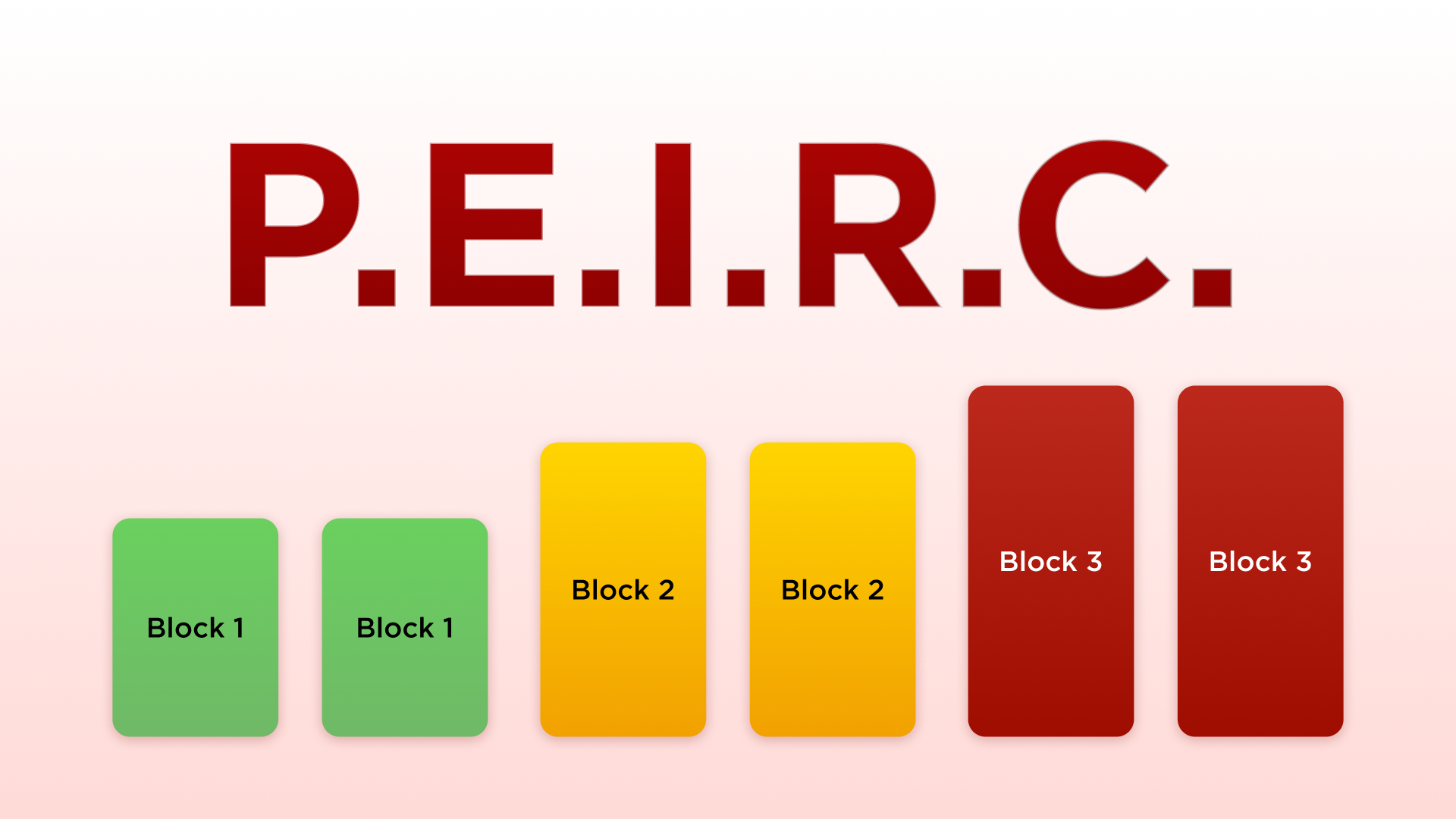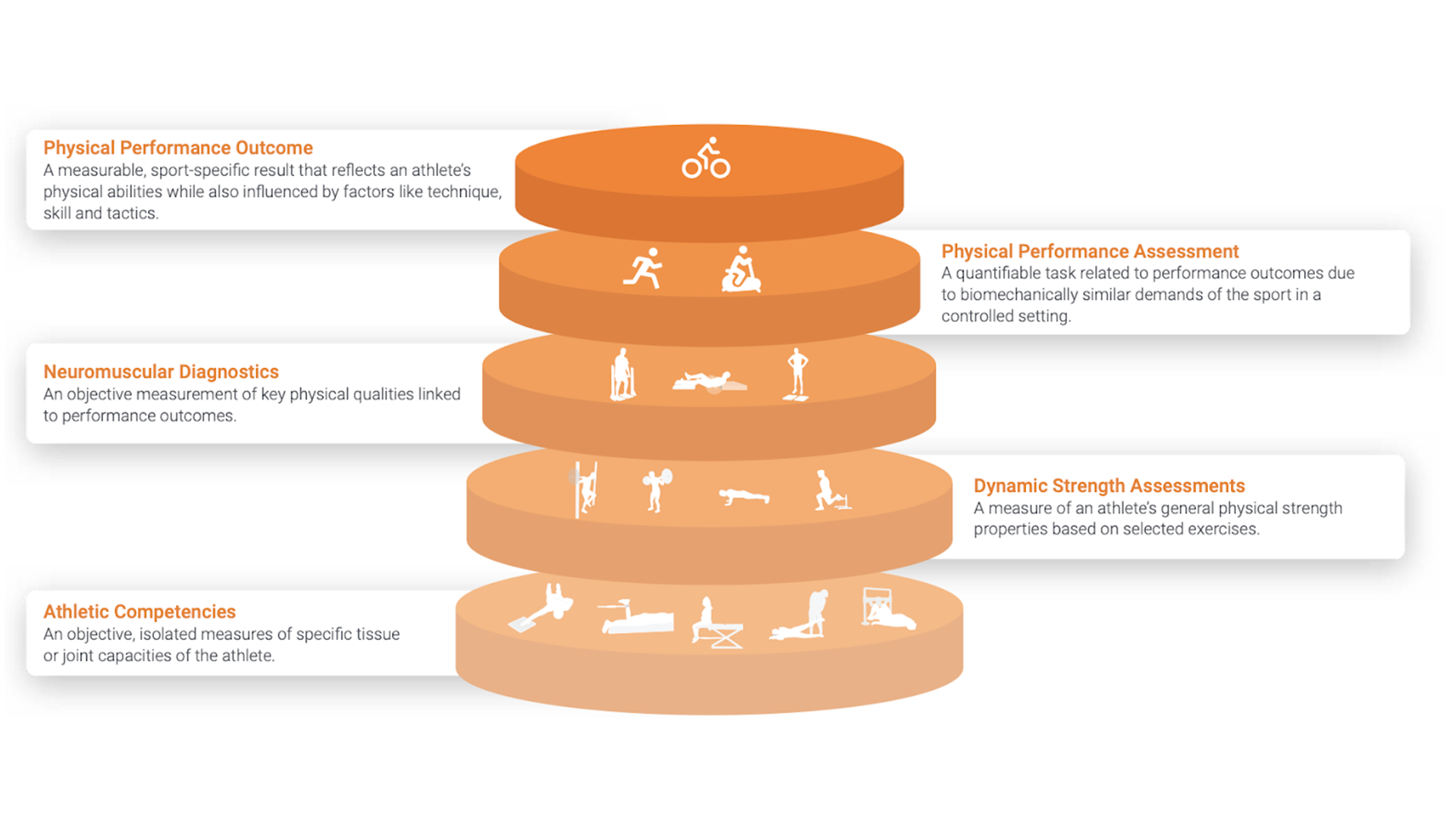A connection with study of Darbellay et al. (2020), written in collaboration with Insiders.
I recently had the pleasure of an insightful conversation with Hannes Pinter about the intricacies of periodisation in sports. What began as a casual exchange of ideas on LinkedIn evolved into a deep discussion during a video call, where we explored periodisation frameworks, volume and intensity metrics, and progression strategies across different mesocycles. Our discussion highlighted the importance of connecting tactical priorities to physical outputs and aligning training with game demands—a concept echoed in Darbellay et al.’s research on workload monitoring in soccer.
This blog synthesizes our conversation and connects it to Darbellay et al.’s study (2020.), providing a comprehensive view of modern periodisation, workload management, and the tools that bridge the gap between science and practice.
Purpose of the Darbellay Monitoring Study
Darbellay et al. aimed to compare traditional speed metrics with the metabolic power (MP) approach to analyze physical efforts. Their work highlights the limitations of conventional metrics in capturing the demands of soccer, emphasizing the value of individualized and dynamic monitoring. This aligns perfectly with the principles of periodisation, where understanding volume and intensity metrics is key to structuring effective training programs.
Defining Volume and Intensity: What Are We Measuring?
One of the central questions in our conversation was: What variables truly represent volume and intensity in a periodisation framework? While it’s common to observe the ebb and flow of volume and intensity over a season, identifying what specifically constitutes these variables is critical for structuring effective plans.
For instance:
- Volume could be represented by: total distance (meters or kilometers covered in training or games), duration of sessions (time spent performing), the number of sprints or high-speed running (HSR) efforts
- Intensity might be reflected in: % of 1RM in strength training, sprint speed thresholds (e.g., max velocity efforts), high-intensity accelerations and decelerations, the density of efforts (repeated bouts of activity with short recovery times)
We both agreed that understanding what you are progressing is key. Whether it’s strength development (%RM), aerobic capacity (total distance), or neuromuscular stress (acc/dec), periodization must align with the demands of the sport, the team’s philosophy, and the players’ individual profiles.
In their study, Darbellay et al. used Insiders GPS devices to collect data from U18 elite players during 13 matches and training sessions. These devices provided detailed insights into:
- Traditional Speed Metrics: Including fixed and individualized thresholds.
- Metabolic Power: Capturing acceleration, deceleration, and energy costs, offering a more realistic representation of effort.
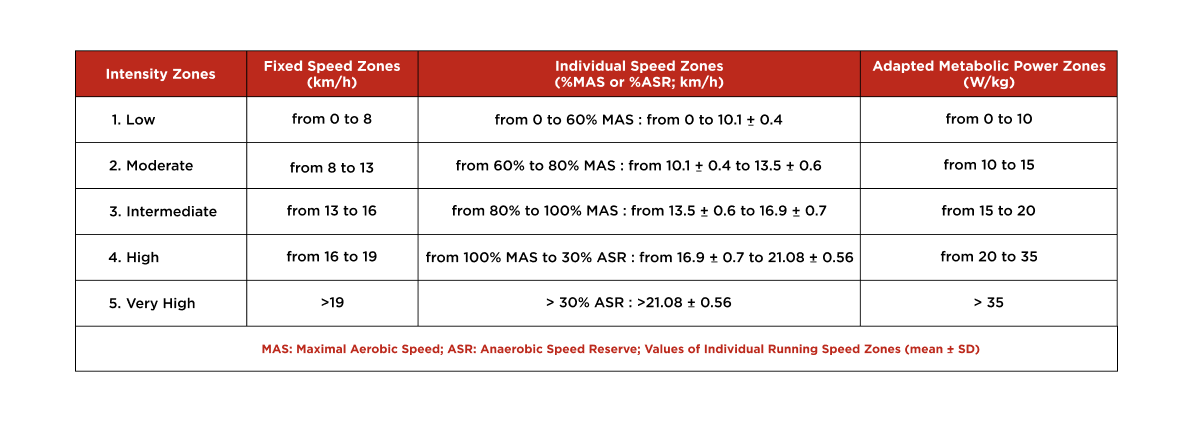
Fitness tests, such as Yo-Yo Intermittent Recovery and sprint tests, were used to individualize thresholds, ensuring accurate workload classification. At Ultrax, we are proud to collaborate with Insiders (formerly FieldWiz), integrating their data into our systems to provide coaches and sports scientists with a holistic view of player performance. This data and devices are also incorporated into our mentorship programs, preparing the next generation of performance professionals to use these tools.
Key Insights from Darbellay et al.
Metabolic Power (MP) Captures True Efforts?
MP metrics revealed significantly higher high-intensity efforts compared to traditional speed-based thresholds, particularly during matches and small-sided games (SSGs). This supports the idea that accelerations, decelerations, and changes in direction are critical components of soccer’s physical demands.
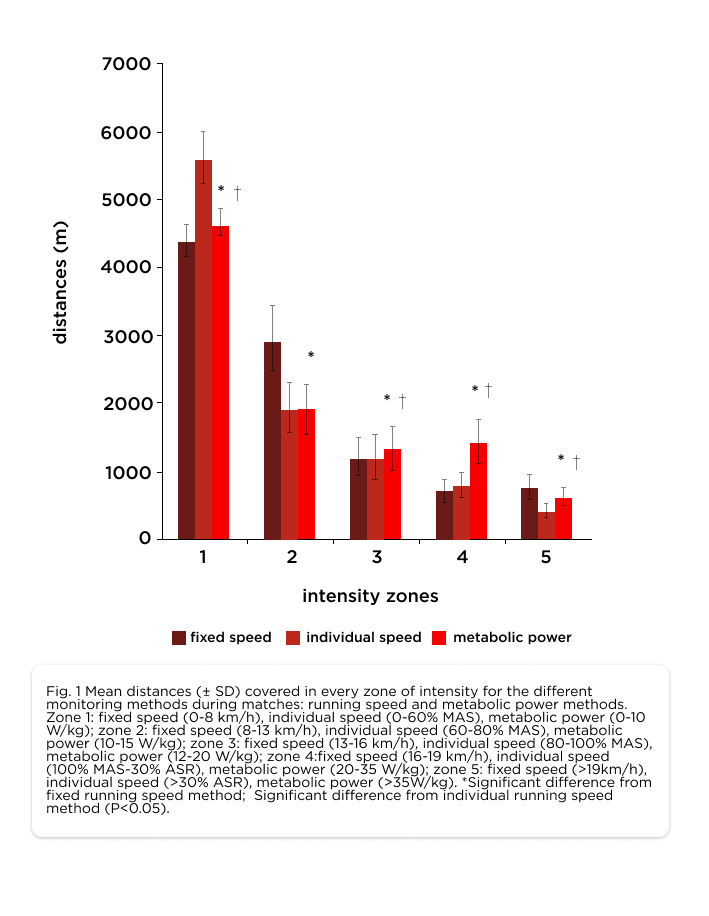
Training vs. Match Workloads
Matches imposed greater overall demands, while smaller-sided games (e.g., 4 vs. 4) elicited more relative high-intensity efforts than larger-sided games. This distinction is vital for periodisation, as SSGs can be tailored to replicate specific match demands.
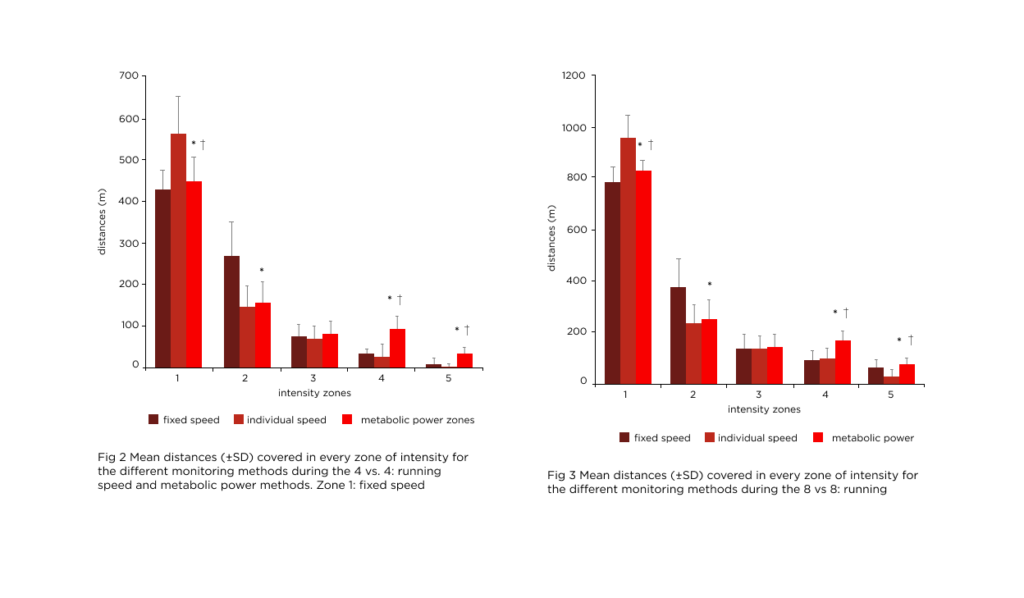
The Gap in Traditional Metrics
Fixed thresholds underestimated workload intensity, while individualized thresholds and MP provided a clearer picture of the dynamic nature of soccer.
According to the study, we can notice that different game formats elicit different adaptations and reactions to the body of the athlete. Connecting with Hannes and this research I wanted to propose a periodisation idea of six weeks that connects tactical principles and selection of the drills. These drills depending if they are small, medium or large sized will have consequences on collecting different types of variables and then impact on metabolic processes in the players body.
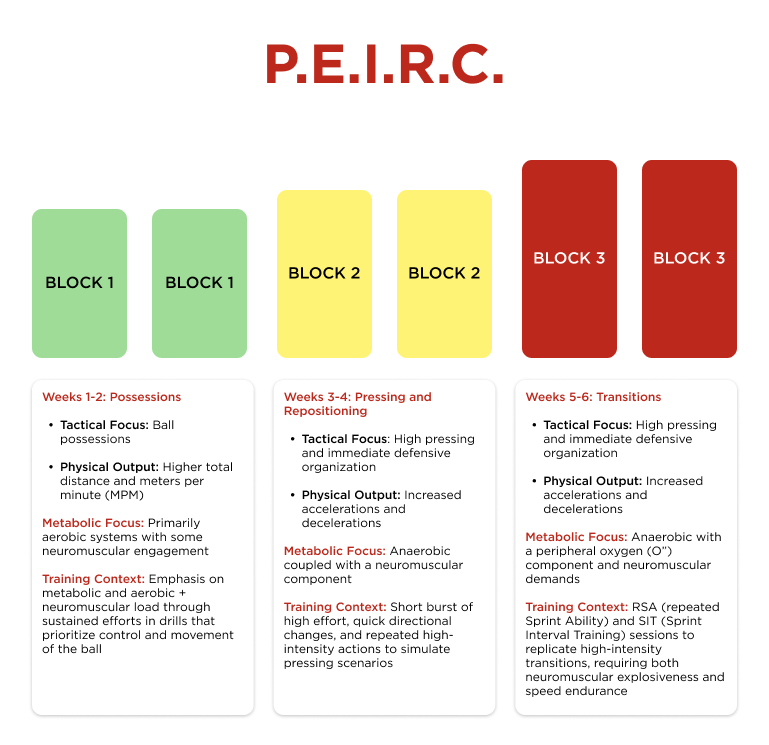
The progression flowed seamlessly from tactical focus to physical demands:
- Weeks 1-2: Possessions
- Tactical Focus: Ball possession
- Physical Output: Higher total distance and meters per minute (MPM)
- Metabolic focus: Primarily aerobic systems with some neuromuscular engagement
- Training Context: Emphasis on metabolic and aerobic + neuromuscular load through sustained efforts in drills that prioritize control and movement off the ball
- Weeks 3-4: Pressing and Repositioning
- Tactical Focus: High pressing and immediate defensive organization
- Physical Output: Increased accelerations and decelerations
- Metabolic focus: Anaerobic systems coupled with a neuromuscular component
- Training Context: Short bursts of high effort, quick directional changes, and repeated high-intensity actions to simulate pressing scenarios
- Weeks 5-6: Transitions: Tactical Focus
- Fast transitions between attack and defense
- Physical Output: More high-speed running (HSR) and sprints
- Metabolic focus: Anaerobic with a peripheral oxygen (O2) component and neuromuscular demands
- Training Context: RSA (Repeated Sprint Ability) and SIT (Sprint Interval Training) sessions to replicate high-intensity transitions, requiring both neuromuscular explosiveness and speed endurance
Connecting Energetic Systems with Periodisation and GPS Variables in the Color Coding Framework
The graph represents the relationship between heart rate (HR) and blood lactate concentration, segmented into three primary zones: Zone 1-2 (green), Zone 3 (yellow), and Zone 4+ (red). These zones reflect varying levels of energetic system demands:
- Green Zone (Aerobic Threshold):
- Characteristics: Heart rates are lower, lactate concentration remains under the aerobic threshold (~2-4 mmol/L), and the focus is on aerobic metabolism.
- Application in Football: Activities in this zone are predominantly aerobic and include low-intensity efforts such as recovery runs, tactical drills emphasizing possession, and general conditioning.
- Color Coding in GPS: Total distance and meters per minute (MPM) are higher because efforts are sustained over longer durations but with less neuromuscular strain. This aligns with Weeks 1–2 of the periodisation model, focusing on possessions with aerobic + neuromuscular components.
- Yellow Zone (Lactate Threshold):
- Characteristics: Heart rate increases, lactate levels rise above the aerobic threshold, and metabolic stress shifts toward anaerobic glycolysis.
- Application in Football: This zone corresponds to medium-to-high intensity efforts such as pressing drills, repeated accelerations and decelerations, and small-sided games (SSGs). It represents a balance between anaerobic and aerobic systems.
- Color Coding in GPS: Variables like accelerations, decelerations, and high-intensity actions become more relevant. This zone dominates during Weeks 3–4, which focus on pressing and repositioning with a high metabolic anaerobic and neuromuscular load.
- Red Zone (VO2max):
- Characteristics: Heart rates and lactate concentrations are at their peak, indicating maximal effort and reliance on anaerobic systems, peripheral oxygen (O2) utilization, and neuromuscular explosiveness.
- Application in Football: High-speed running (HSR), sprints, and transitions fall into this zone. Tactical scenarios like counterattacks or defensive transitions demand maximum intensity.
- Color Coding in GPS: HSR, sprints, and repeated sprint ability (RSA) metrics dominate in this phase. This corresponds to Weeks 5–6, emphasizing transitions with sprint interval training (SIT) and explosive movements.
How Games and GPS Variables Fit Within These Zones
- Green Zone Games:
- Example: Possession-focused training matches or low-intensity recovery drills.
- GPS Variables: High total distance and MPM with fewer sprints, accelerations, and decelerations.
- Impact: Primarily aerobic with low neuromuscular stress, ideal for technical and tactical development without excessive fatigue.
- Yellow Zone Games:
- Example: Pressing-oriented games or medium-sized positional drills.
- GPS Variables: Moderate total distance, a high density of accelerations and decelerations, and increased metabolic cost.
- Impact: Develops anaerobic capacity and neuromuscular strength, enhancing ability to sustain high-intensity actions.
- Red Zone Games:
- Example: High-intensity small-sided games (e.g., 3v3) or transition-focused tactical drills.
- GPS Variables: High HSR and sprint counts, repeated sprints, and elevated metabolic and neuromuscular load.
- Impact: Simulates match scenarios requiring maximum effort, improving speed endurance and peak performance.
By using a color-coded framework, coaches can strategically assign games and drills based on the desired energetic and neuromuscular demands:
- Green Days: Focus on aerobic recovery or technical-tactical drills with low neuromuscular and metabolic impact.
- Yellow Days: Target metabolic thresholds with pressing or high-acceleration drills to improve anaerobic efficiency.
- Red Days: Prioritize explosive transitions, speed endurance, and high-intensity sprinting efforts.
Conclusion
The conversation with Hannes Pinter highlighted the importance of aligning tactical priorities with physical outputs in periodisation. This approach, supported by Darbellay et al.’s findings, emphasizes the need for advanced metrics like Metabolic Power (MP) to better reflect the demands of soccer. Their study showed how MP provides more precise insights into high-intensity actions compared to traditional metrics, bridging the gap between tactical planning and physical performance.
By integrating tools like Insiders and Ultrax systems, coaches can connect tactical ideas—such as possession, pressing, and transitions—with physical variables like heart rate zones, high-speed running (HSR), and accelerations. The practicality of a color-coded system further simplifies this process, linking drills and GPS data to specific training intensities, from aerobic-focused green zones to anaerobic-intensive red zones.This framework ensures training sessions are not only scientifically grounded but also tactically meaningful, enabling teams to optimize performance, manage fatigue, and minimize injury risk.
Integrating Tactical and Physical Workloads
Use MP metrics to align training drills with tactical priorities. For example, pressing drills should focus on high-intensity actions (acc/dec), while transition drills should emphasize sprinting and high-speed running.
Tracking and Managing Fatigue
With tools like Insiders, coaches can monitor workload progression and ensure players are not overtrained. Ultrax’s integration allows for seamless data analysis, providing actionable insights and giving the full picture to the data. Ultrax software with all the data points can tell you a better story of what is happening with your players.
Student Education and Mentorship
By exposing our students to tools like Insiders and principles from studies like Darbellay et al., we empower them to bridge the gap between theory and practice in their future careers.

